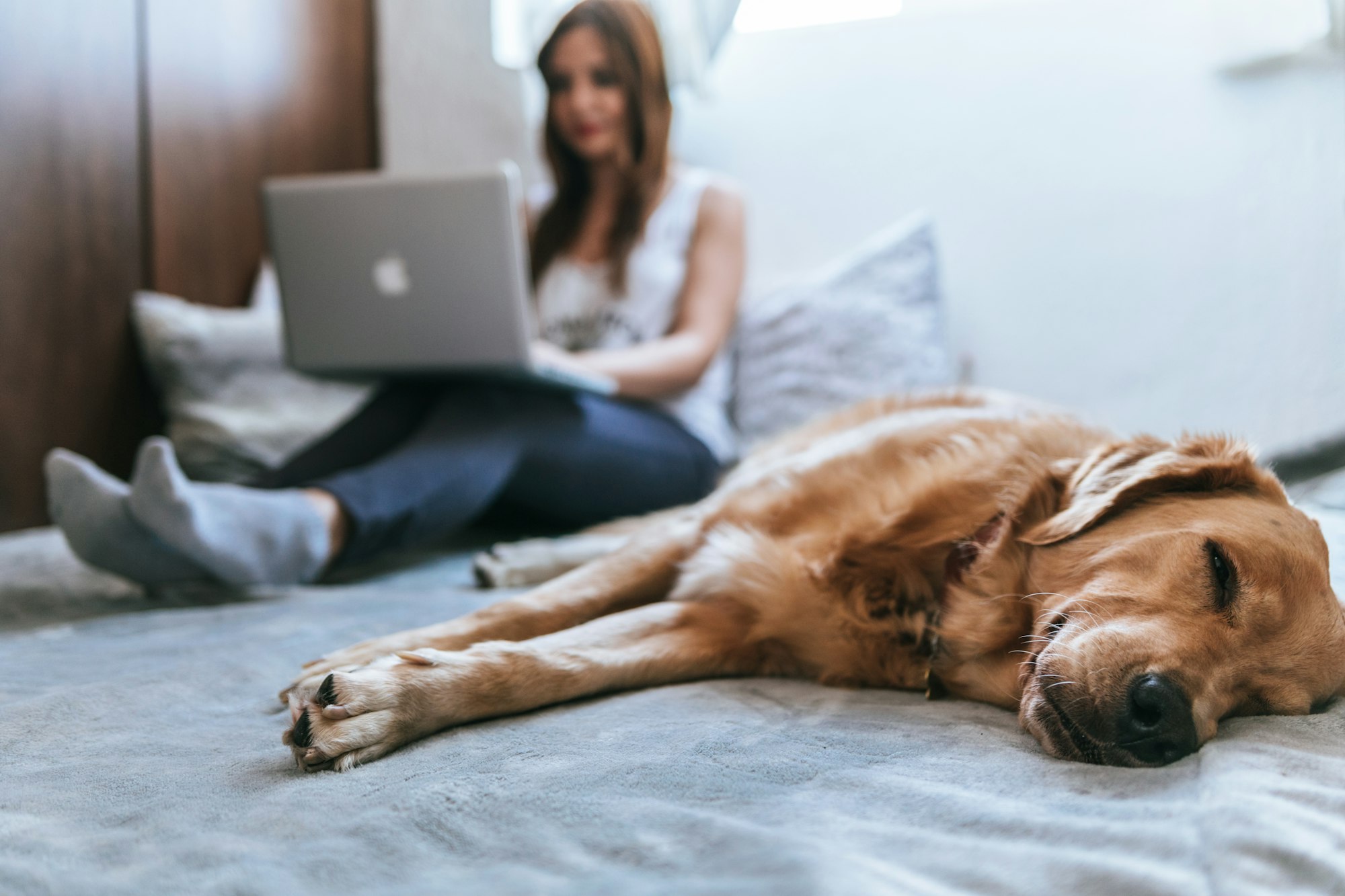You're lounging in your living room after a busy day, perhaps sipping on a refreshing drink. Suddenly, you notice Rover entering, but something is off. Instead of the usual lively trot, he's limping. Your heart skips a beat. The inevitable question pops in your mind: why is my dog limping?
Understanding the Limp
It's the same worry that countless dog owners feel when they see their furry friend in distress. It's like watching your child trip and fall. But dogs, much like humans, can suffer from various ailments that cause them to limp.
Let's take Sarah, for instance. Sarah had always enjoyed fun with her dog at the park every weekend. But one Saturday, she noticed her golden retriever, Max, limping after chasing the frisbee. This wasn't the energetic Max she knew.

Common Causes of Limping in Dogs
Injury
Just like humans, dogs can have accidents. Maybe they stepped on something sharp during a walk, or perhaps they played a bit too rough with other dogs. It could be a minor paw injury or something as severe as a broken bone.
Arthritis
Dogs, especially the older ones, are susceptible to arthritis. A lifetime of running, jumping, and playing can take a toll on their joints. So, if you find your senior dog limping, it might be a sign of arthritis setting in.
Hip Dysplasia
Some breeds are genetically predisposed to conditions like hip dysplasia. This condition affects the hip joint and can be quite painful, leading to a noticeable limp.
Ligament Injuries
Remember the story of Sarah and Max? After a visit to the vet, it turned out Max had a ligament injury, a common ailment in active dogs.
Solutions to Address Limping
Immediate Care
If you notice your dog limping, the first step is to remain calm. Examine their paws gently. Look for signs of injuries like cuts or thorns. Sometimes, the solution could be as simple as removing a small pebble stuck in their footpad.
Consultation
It's crucial to consult a vet if the limping persists. They will provide a thorough check-up, identifying issues that might not be visible to the untrained eye.
Physical Therapy
Just as humans benefit from physiotherapy, dogs do too. A series of sessions might help in improving joint mobility and reducing pain.
Medications
Vets might prescribe pain relief or anti-inflammatory drugs to provide relief from conditions like arthritis or ligament injuries.
Surgery
In extreme cases, especially with conditions like hip dysplasia, surgery might be the recommended route.
Linking it All Together
It's essential to understand that limping in dogs is not always a sign of something severe. Sometimes, they might just have had a minor mishap, like tripping while playing, much like a kid having fun.
However, there's another side to this. Imagine a rescue dog. Before being rescued, these dogs might have gone through trauma or neglect, leading to chronic issues that cause limping. That's why rescue organizations always emphasize medical check-ups for such dogs.
Now, imagine taking your dog to a dog restaurant. It's a fun outing, right? But if your pet is limping, it might be hard for them to maintain proper dog restaurant etiquette, like sitting still or not causing disruptions.
Then there's the aspect of play. Have you ever noticed dogs shake their toys? It's their instinctual behavior. But if a dog is limping, this playful act might be curtailed.
Interestingly, dogs have a remarkable ability to recognize faces. So, if they've been hurt by someone, they might associate the pain with that person and limp out of fear or anxiety when they see them again.
And while it's painful to think about, dog death is an inevitable part of a pet owner's journey. Sometimes, aging or terminally ill dogs might limp due to underlying health issues.
Prevention is Better than Cure
Beyond addressing the immediate concern of limping, it's crucial to think about preventive measures. After all, our fur babies depend on us for their wellbeing.
Regular Vet Check-ups
Make it a practice to visit the vet regularly. These routine checks can help detect potential problems before they escalate. Your vet can also guide you on supplements or exercises that can be beneficial for your dog's joint health.
Quality Diet
Feeding your dog a balanced, high-quality diet can make a world of difference. Proper nutrition ensures strong bones and muscles, reducing the risk of injuries. Some diets are specifically formulated for joint health, which can be particularly beneficial for breeds prone to hip dysplasia or arthritis.
Weight Management
A significant cause of stress on a dog's joints is excess weight. Ensure your dog maintains an optimal weight to reduce the strain on their joints and bones. This not only reduces the risk of limping but also promotes overall health.
Proper Exercise
Exercising your dog doesn't just mean letting them run wild. Tailor their activities based on their breed, age, and health. Puppies, for instance, have delicate joints, so avoid high-impact exercises. Older dogs, on the other hand, may benefit from low-impact activities like swimming.
Paw Care
Something as simple as checking your dog's paws after walks can prevent minor injuries that lead to limping. Trim their nails regularly, and during winters, be cautious of salt on sidewalks which can be harmful.
Safety First
If your dog loves car rides, ensure they're safely strapped in. Many dogs get injured from jumping out of vehicles. Also, consider investing in dog boots or protective gear if you're hiking rough terrains.
Educate Yourself
The more you know, the better. Attend pet care workshops or seminars. Many organizations offer classes on first aid for pets. This knowledge can be invaluable in emergencies.
Emotions Behind the Limp
The physical aspect of limping is just one side of the coin. Dogs, much like us, have emotions that sometimes reflect in their physical demeanor. A limp might be an expression of more than just a physical ailment.
Fear and Trauma
Dogs can experience traumatic events, whether it's from past abuse, a particularly scary encounter with another animal, or a loud and frightening noise like fireworks. This trauma can manifest in various ways, including limping, even if there isn't a physical injury present.
Seeking Attention
Dogs are incredibly intuitive and quickly learn what gets them attention. If they've limped once due to a genuine injury and received extra love and care, some dogs might display limping behavior to get that same attention again. This isn't them being deceptive; it's merely a way of saying, "Hey, I loved that extra fuss you made over me!"
Behavioral Limping
Some dogs might start limping after seeing another dog do the same. It's a quirky behavior, yes, but dogs often mimic others, whether it's their furry peers or even their human companions.
Strengthening the Bond
As pet owners, these situations provide opportunities to strengthen the bond with our furry companions. Every limping episode is a chance to show our pets that we're there for them, in sickness and in health.
Quality Time
When your dog is limping, it's essential to spend quality time with them. Comfort them, cuddle them, or just sit by their side. This reassurance can speed up their recovery, both physically and emotionally.
Play Safe
We mentioned fun with your dog earlier, but it's worth noting the importance of safe play. Avoid rough games that can lead to injuries. Instead, opt for gentle games that both of you can enjoy without any risks.
Socializing
Socializing is an essential aspect of a dog's life. It helps them understand the world around them better. By exposing them to different situations, people, and other dogs, they become more adaptable and resilient. So, if they're ever in a situation that's not to their liking, like not knowing the dog restaurant etiquette, they can handle it better.
The Modern Solution: Fi Dog Collars
In today's digital age, our approach to pet care has transformed remarkably. It's not just about the toys we buy or the food we provide. It's also about the technology we use to ensure their safety and health. One such technological marvel that aligns seamlessly with our discussion on limping dogs is the Fi dog collar.
Monitoring with Fi
When we discussed the causes of limping, we delved into various reasons, from physical injuries to emotional distress. The Fi dog collar, being a smart device, can monitor your dog's activity levels. This can be particularly useful to detect any sudden drops in activity, which might be a sign of discomfort or pain.
Safety First
Remember the concerns about dogs limping due to accidents or injuries? The Fi collar can be a lifesaver here. It comes with GPS tracking, ensuring you always know your dog's whereabouts. This feature reduces the risks of accidents as you can ensure your dog isn’t wandering into unsafe territories.
Enhancing Playtime
While we talked about fun with your dog and the significance of safe play, the Fi collar can add another layer to this fun. It tracks your dog's steps, much like a Fitbit for humans. You can set daily step goals for your dog, ensuring they get the right amount of exercise without overexerting.

Socializing and Adventures
Considering how important it is for dogs to socialize, imagine going on adventures, maybe even to a dog restaurant, and not having to worry constantly about your furry friend wandering off. The real-time GPS tracking of the Fi collar ensures that even if your dog gets distracted by something interesting (like not knowing the dog restaurant etiquette and chasing after a delicious smell), you can locate them instantly.
Embracing Technology for Emotional Bonds
Though the Fi collar is a piece of technology, it's designed with the emotional bond between pets and owners in mind. By keeping track of their activity and location, it provides peace of mind to dog parents, allowing them to focus entirely on creating memories, be it watching their dogs shake their toys or marveling at how they recognize faces from a distance.
Conclusion:
Limping in dogs can arise from various causes, ranging from minor injuries to more severe underlying health issues. As responsible pet owners, it's crucial to observe our dogs closely and take any signs of distress or discomfort seriously. Immediate attention and timely intervention can prevent complications, alleviate pain, and ensure a faster recovery.
While some causes of limping, such as minor sprains or foreign objects, can be addressed with home care, others like fractures or severe diseases necessitate professional veterinary intervention. It's always best to err on the side of caution and consult a veterinarian if you're uncertain about the cause or if the limping persists. Through understanding, vigilance, and proactive care, we can ensure our canine companions remain healthy and active throughout their lives.






